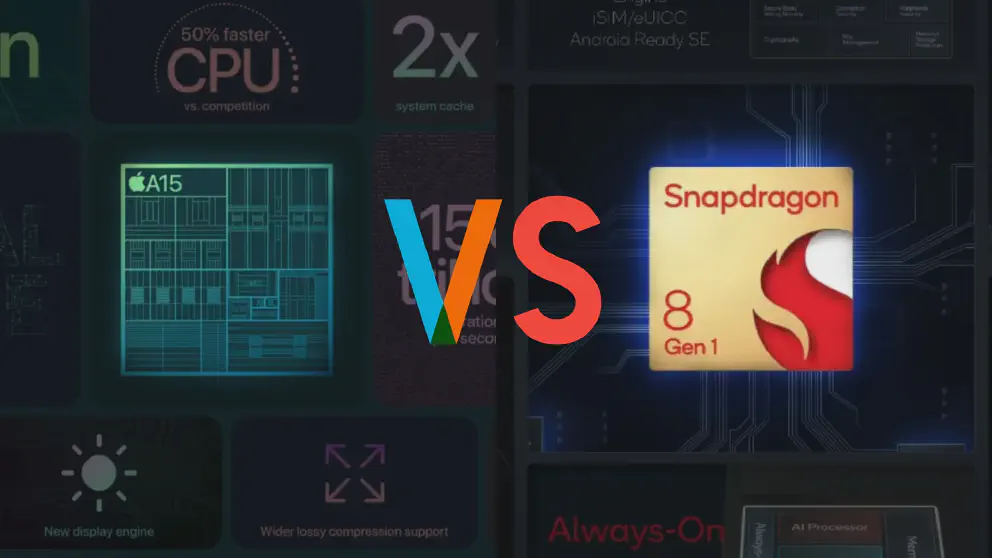Qualcomm updated their mobile chip offering for 2022 in late November 2021. Unlike previous iterations, the new chip has a new naming convention, dubbed SnapDragon 8 Generation 1. The name change signifies a paradigm shift for Qualcomm as the manufacturer uses a brand new architecture for the SnapDragon 8 Gen 1. Since then, the SnapDragon 8 Gen has appeared on the usual suspects of flagship phones: the Xiaomi 12, Samsung Galaxy S22 series, Motorola Edge 20 Ultra and the Oneplus 11 Pro.
However, the details continue? Can it finally beat the performance crown which is Apple’s A15 Bionic and can the architecture be extended for desktop uses like what Apple did for the M1 chip? We investigate.

Executive Summary:-
- Qualcomm SnapDragon 8 Gen 1 is a continuation of SnapDragon 888 chip with upgraded cores and manufacturing process
- Performance-wise, the Apple A15 is still the SOC to beat but the SnapDragon has higher graphic performance.
- A name change indicates a more evolutionary approach moving forward as the smartphone market is getting more and more mature.
Qualcomm Snapdragon 8 Gen 1

On the surface, Qualcomm looked like it just updated the internal cores from the SnapDragon 888 / 888+ and called it a day. It is much more than that. For one, the SnapDragon 8 Gen 1 is one of the first SOC that uses ARM’s new architecture: the ARMv9.
The ARMv9 is ARM’s first architecture revision in 10 years. Where Apple would be the first company to introduce 64-bit computing which was later incorporated into ARMv8, the ARMv9 introduced a lot of functional improvements. ARM’s own reference design, the Cortex has 16% improvement over the older design. The ARMv9 focuses on bringing out more performance from the high-efficiency LITTLE cores. Security is also improved with ARM Confidential Compute Architecture (CCA). The concept is to have multiple dynamic realms aka having multiple secure enclaves in your own SOC.
With collaborating with Fujitsu, ARM managed to bring some of the Supercomputing prowess into the mobile chip in the form of Scalable Vector Extension version 2. The first version was developed for Fujitsu own’s supercomputer the Fugaku. Having a vector register in the chip allows for faster Machine Learning processing.
The layout of the SnapDragon 8 Gen 1 is retained from the previous version: one ultra high performance cores, 3 performance cores and 4 efficiency cores. The high performance cores had their speed bumped up slightly to improve throughput. The modem also has been bumped from X60 to X65 which allows it to support 10 Gigabyte 5G network.
One of the major changes is that the manufacturing process is slightly improved from 5 nanometers to 4 nanometers from Samsung and TSMC, making it one of the first manufacturers to do so. In conclusion, the SnapDragon 8 Gen 1 looks like a spec bump from the outside, but internally, it’s a complete design revision.
Apple A15 and M1
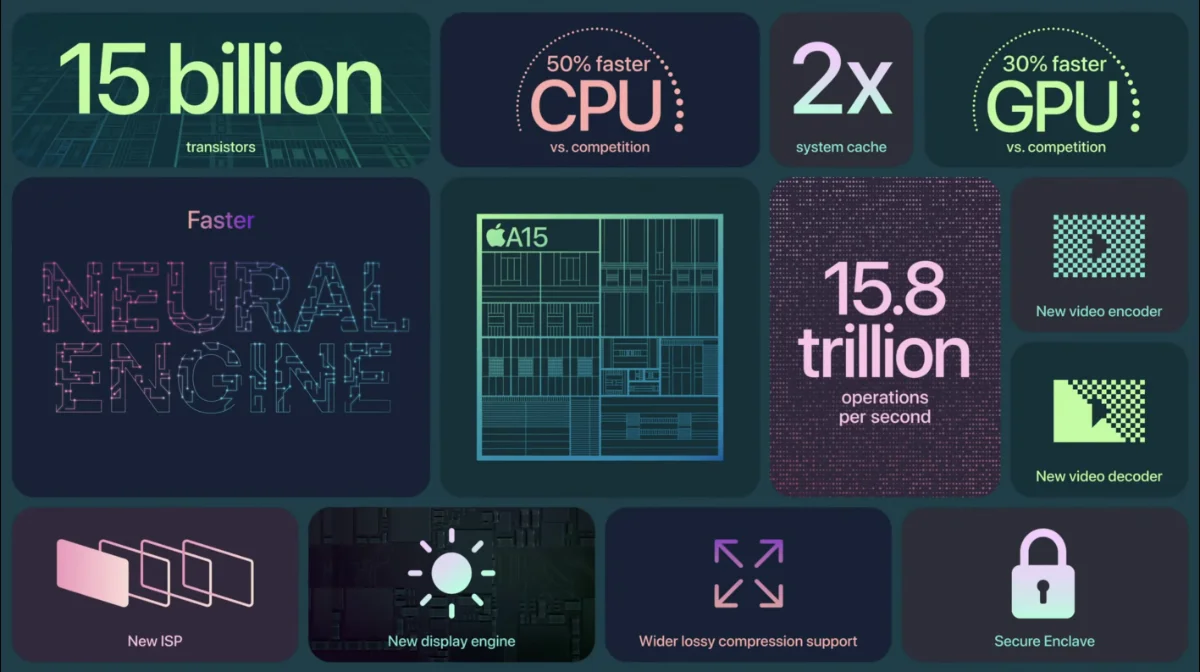
The A15 Bionic is Apple’s current flagship mobile SOC. It is used in the iPhone 13, iPhone 13 Pro and iPad Mini. Many pundits declare that the A15 chip is just a spec bump or minor revision over the A14 chip but the devil is always in the details.
For the first time, Apple has multiple versions of the A15, denoted by the GPU core count and clock speed. For the normal iPhone 13, the A15 has 4 GPU cores, while the iPhone 13 Pro has 5 GPU cores. Although the iPad Mini has the 5-core version of the A15, it is detuned a bit compared to the iPhone 13 Pro.
Just like the A14 Bionic, the A15 has 2 performance cores and 4 efficiency cores, a neural engine, Apple fabric. And for the first time, media engine is also incorporated in the A15 chip which enables the iPhone 13 Pro to shoot in ProRes. With ProRes records around 1GB per second, it’s quite an achievement.
Here’s some bonus content. The M1 chip. Why would we include a laptop chip in the comparison? Because the SnapDragon would also be powering some tablets, so one can assume that the SnapDragon 8 Gen 1 will be powering a manufacturing flagship table. In Apple’s lineup, that would be the iPad Pro which is currently running on M1. Putting an M1 on the iPad Pro is a great technical achievement from Apple, although it just make the iPad Pro overpowered for its limited use.
With 4 high performance cores, 4 high efficiency cores, Neural engine, Apple Fabric and I/O that can enable it to drive a 6K monitor while consuming less that 10 watts, the M1 packs a mean punch especially when put in a tablet form factor.
Benchmarks Comparison
So from the benchmark, we can see the story is still the same. The graphics in the SnapDragon 8 is faster but everything else the A15 just owns it. The M1 beats the SnapDragon 8 in the graphics department, but that is due to the sheer number of graphic cores in the M1. Benchmark says one thing, but in real life, both chips are very competitive.
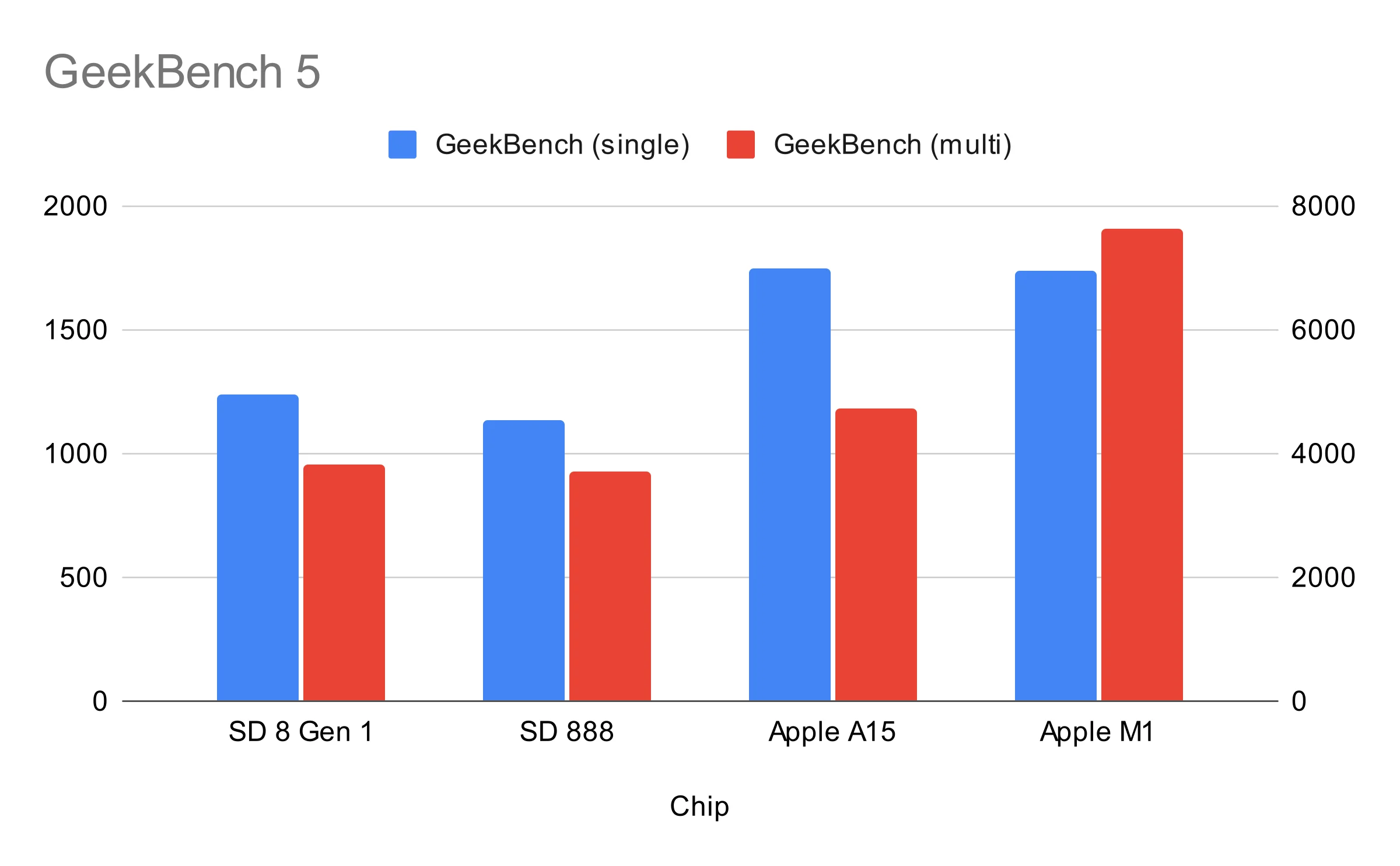
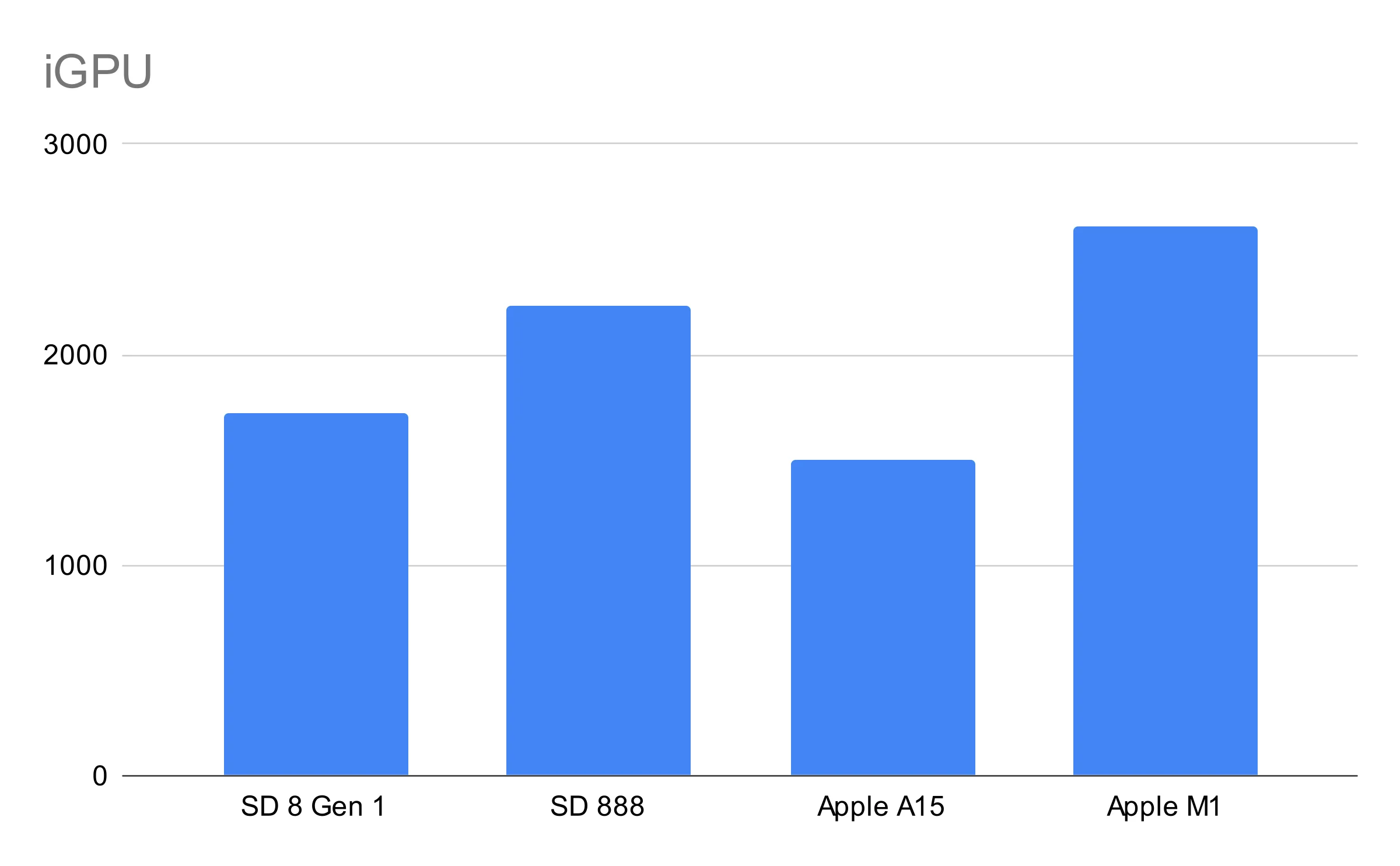
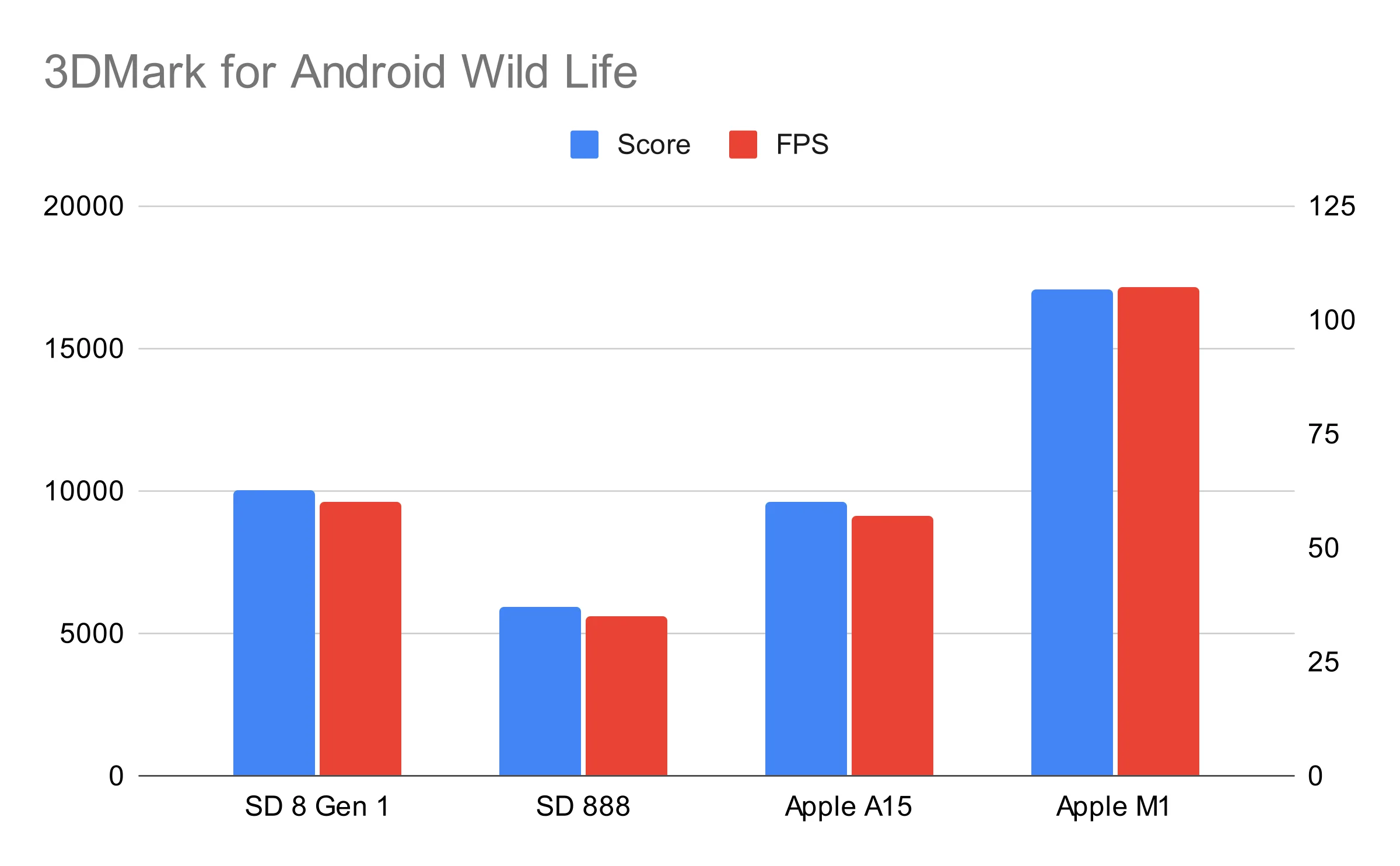
Conclusion
On the surface, the SnapDragon looks like an evolutionary year on year step compared to how mobile chips are coming out 5 years ago. To be fair, Apple also has the same perception problem, the A15 just looks like a spec bump of the A14.
Internally, just like the A15, the SnapDragon 8 Gen 1 is a revolutionary in its own right. A new architecture and a new manufacturing process requires a lot of work by itself. And with new revisions of the chip with programs that push the boundaries of what’s possible, that’s revolutionary.
But on the other hand, the reality has sinked in: the smartphone has reached or nearing its peak. To be honest, smartphone chips are way too powerful than its normal use case, except for mobile gaming. If there’s any major room for improvement, it would be in the neural processing and graphic performance, not the general purpose chip.
Plug
Support this free website by visiting my Amazon affiliate links. Any purchase you make will give me a cut without any extra cost to you
- iPhone 13 Mini - Amazon USA / Amazon UK
- iPhone 13 - Amazon USA / Amazon UK
- iPhone 13 Pro - Amazon USA / Amazon UK
- iPhone 13 Pro Max - Amazon USA / Amazon UK
- iPhone SE - Amazon USA / Amazon UK
- iPad Mini - Amazon USA / Amazon UK
- iPad - Amazon USA / Amazon UK
- iPad Air - Amazon USA / Amazon UK
- iPad Pro - Amazon USA / Amazon UK
- Accessories:-
- AirPods - Amazon USA / Amazon UK
- AirPods Pro - Amazon USA / Amazon UK
- AirPods Max - Amazon USA / Amazon UK
- MagSafe Cable - Amazon USA / Amazon UK
- 20W Charger - Amazon USA / Amazon UK
- MagSafe Case - Amazon USA / Amazon UK
